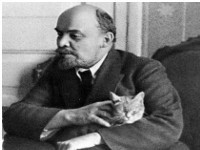Can anyone complete portrait of Lenin?
Vladimir Lenin passed away 90 years ago. One of the most-quoted thinkers and pioneers on the way to create a society of social justice, Lenin then turned into a popular character for jokes and a weapon to advocate operations, the essence of which had little to do with historical truth. What kind of a person was the most famous Russian of the 20th century?
"Lenin's portraits are nowhere to be seen; no other portraits will be like his, and it appears that centuries will finish off the portrait that was left incomplete." It is an open secret that Vladimir Ulyanov (Lenin), saw himself as a writer and journalist. The most important thing in the life of that journalist was revolution. He had other followers when it comes to this, for example, political journalist Benito Mussolini. By the way, the would-be leader of the proletariat, Lenin had personally met the future Italian fascist leader Mussolini. Both revolutions destroyed their creators in their own ways. Italians desecrated Mussolini's body by hanging him upside down next to his dead lover. The Russians still carefully preserve the body of their leader in the mausoleum.

They say that revolution devours its children. Lenin, who devoted his entire adult life to preparing a revolution in Russia, doubted that his generation would have time to enjoy the fruits of the revolution. In February 1917, Vladimir Ulyanov, aka Lenin, was almost 47 years. The aging revolutionary and his not very pretty wife were living as expats in Switzerland, huddling in a small room that they were renting from a local worker. They were short of money, living from hand to mouth.
Lenin sent a letter to Petrograd, to Mark Elizarov, with a request to assist in the publication of an educational encyclopedia or a dictionary edited by his wife, Nadezhda Krupskaya. The future gravedigger of the Russian bourgeoisie asked revolutionary Mark Elizarov to find a bourgeois to fund the project. Lenin had no doubts about the profitability of such an enterprise. "Nadezhda can do this, I'm sure, she was engaged in pedagogy for many years, she wrote a lot about it. Zurich is an extremely convenient place for such work. The pedagogical museum here is the best in the world," he wrote.
We quoted a short excerpt from the letter to prove that the Ulyanovs were a family of limited means on the eve of the coming events. There were days of melancholy too. How could one believe that he would see the Russian revolution? Only few people are capable of doing this. Micah Tshakaya encouraged the party leader, who delivered a speech on the revolution of 1905. Lenin did not forget about it, and as soon as he learned about the February events in Petrograd, he sent Tshakaya a postcard, where, among other things, he noted that his "optimism was soon rewarded." Even after he read the news in Neue Zürcher Zeitung about events in the capital of the Russian Empire, Lenin did not know a lot, despite the fact that his colleagues in the struggle would visit him on a regular basis. When Alexandra Kollontai asked Lenin to give her and the party instructions on how to conduct political work in light of new developments, Lenin refused to give any due to the lack of information.
However, as a purposeful man, Lenin knew only one thing - he had to go to Russia immediately, and launch a socialist revolution there. But how? Europe was suffering from wars. We will not talk about the daring wish of Vladimir Lenin to cross the borders of warring states on an airplane, but here is another example. It is enough to obtain a Swedish passport and learn a few phrases in Swedish, to get to Finland through neutral Sweden and then to Petrograd, to the banks of the Neva River (St. Petersburg). Nadezhda Krupskaya gave her husband a sane piece of advice: "Think what may happen! You'll fall asleep, see Mensheviks in a dream and swear: bastards, you bastards! All the conspiracy will vanish."
The idea with Ganetsky did not work out either. Lenin wrote to this resident in Stockholm: "Me and Zinoviev must get to Russia by all means. The only possible plan is as follows: you have to find two Swedes, who would look like me and Zinoviev, but since neither myself nor Zinoviev know the Swedish language, they have to be deaf and dumb. I'm enclosing our photos for this case." Instead of the deaf Scandinavians, the Polish Jew gave the photograph of Vladimir Lenin to reporters of the Politiken newspaper. The paper soon published the photo with a caption: "Lenin, the leader of the Russian Revolution."
As a result, Lenin decided to resort to the suggestion from a former colleague of his, Mr. Martov. The latter suggested they should address to the German government seeking a permission for Russian immigrants to travel across the German territory in exchange for a similar permission for internment Germans to travel on the Russian territory.
During several days, while waiting for a response from the authorities, Lenin wrote his "Letters From Afar." They did not play any role in February events. Four of the five letters were published only after Lenin's death. The letters contained his thoughts after the events, rather than their visionary foresight. Afterwards, thanks to his fighting spirit, Vladimir Lenin fashioned a revolutionary figure of global and historical scale from a political pariah. He knew what he wanted, but it turned out as always. The revolution killed many lives and accelerated the death of Lenin himself. He died before he turned 54.
Igor Bukker
Pravda.Ru
Subscribe to Pravda.Ru Telegram channel, Facebook, RSS!


